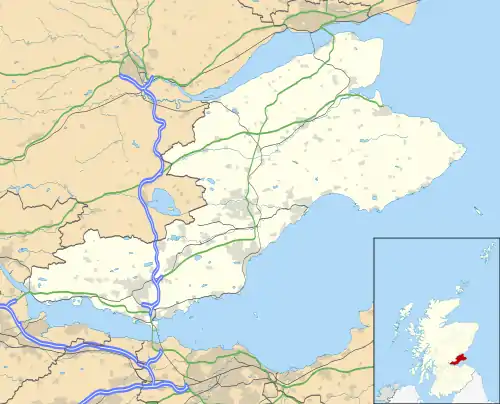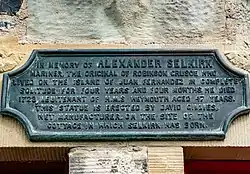Lower Largo
Lower Largo or Seatown of Largo is a village in Fife, Scotland, situated on Largo Bay along the north side of the Firth of Forth. It is east of, and contiguous with, Lundin Links.
| Lower Largo | |
|---|---|
 Lower Largo Location within Fife | |
| Population | 2,390 (mid-2020 est.)[1] |
| Council area | |
| Lieutenancy area | |
| Country | Scotland |
| Sovereign state | United Kingdom |
| Post town | LEVEN |
| Postcode district | KY8 |
| Police | Scotland |
| Fire | Scottish |
| Ambulance | Scottish |
| UK Parliament | |
| Scottish Parliament | |



Largo is an ancient fishing village in the parish of Largo. An excavated late 5th century cemetery points to an early settlement of the site, and there are records of the Knights Templar holding lands to the east of the town in the 12th century. It was made a "burgh of barony" by Sir Andrew Wood in 1513. This meant it had the right to erect a mercat cross and hold weekly markets, but not the extensive trading rights of a royal burgh.[2] In 1654, Dutch cartographer Joan Blaeu mentions Largo as "Largow burne-mouth" in his Nova Fifae Descriptio.
Lower Largo is famous as the 1676 birthplace of Alexander Selkirk, who provided inspiration for Daniel Defoe's Robinson Crusoe.[3] The house that now stands at his birthplace on 99-105 Main Street features a life-sized statue of Selkirk wearing self-made goatskin clothes, scanning the horizon. A signpost at the harbour points to Juan Fernández Islands, some 7,500 miles distant, where Selkirk lived for more than four years as a castaway.
The arrival of the railway in 1857 brought many tourists to Lower Largo's sandy beach. The village has retained many historic buildings from the 17th to 19th century, and in 1978 it was designated as a conservation area.[2]
The Fife Coast Railway line through Lower Largo was closed in 1965 as part of the restructuring programme of British railways known as the Beeching cuts (overseen by Richard Beeching), and though it has been disused since then the viaduct that dominates the village remains an important local landmark.
The war memorial in Lower Largo was designed by Sir Robert Lorimer.[4]
Other notable residents
- James Clunie, British Labour Party politician
- Rev Joseph Taylor Goodsir FRSE, theological author, born in Lower Largo and later its minister
References
- "Mid-2020 Population Estimates for Settlements and Localities in Scotland". National Records of Scotland. 31 March 2022. Retrieved 31 March 2022.
- "Lower Largo Conservation Area Appraisal" (PDF). Fife Council. 2012. Retrieved 6 July 2020.
- Severin, Tim (2002). In Search of Robinson Crusoe. New York: Basic Books. pp. 17–19. ISBN 978-046-50-7698-7.
- Dictionary of Scottish Architects: Robert Lorimer
External links
- Map sources for Lower Largo
- The Largo Trust
- Lower Largo on FifeDirect
- Largo Arts Week - arts festival taking place in the village starting in 2019